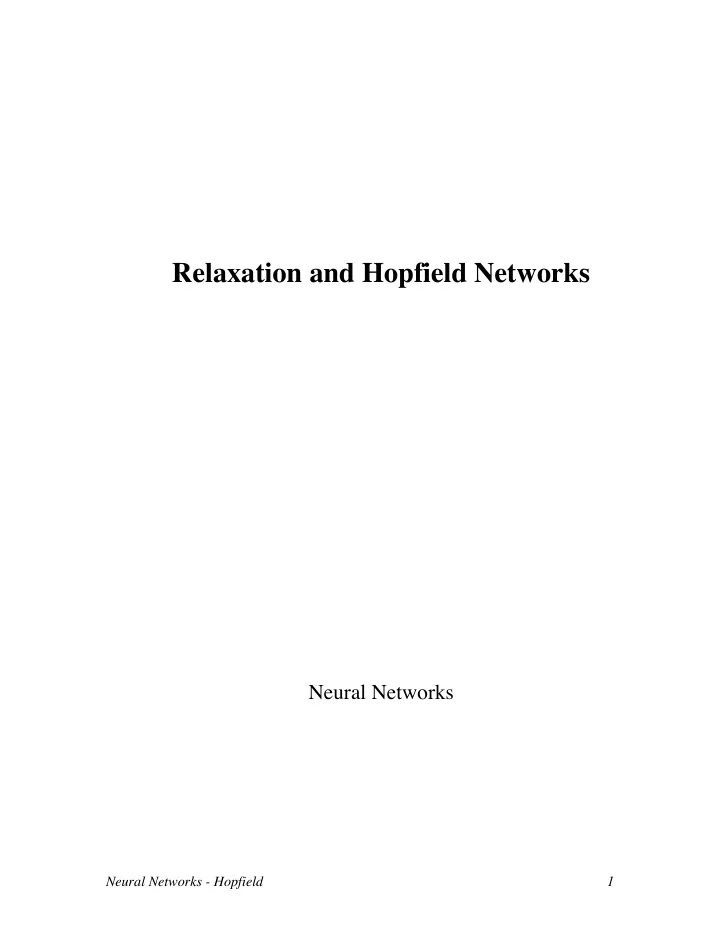

Relaxation and Hopfield Networks Neural Networks Neural Networks - Hopfield 1
Bibliography Hopfield, J. J., "Neural networks and physical systems with emergent collective computational abilities," Proceedings of the National Academy of Sciences 79 :2554-2558, 1982. Hopfield, J. J., "Neurons with graded response have collective computational properties like those of two-state neurons." Proceedings of the National Academy of Sciences 81: 3088-3092, 1984. Abu-Mostafa, and J. St. Jacques, Information Capacity of the Hopfield Model, IEEE Trans. on Information Theory , Vol. IT-31, No. 4, 1985. Neural Networks - Hopfield 2
Hopfield Networks Relaxation Totally Connected Bidirectional Links (Symmetric) Auto-Associator 1 0 0 1 1 0 0 1 0 0 0 0 1 1 1 0 1 0 1 1 Energy Landscapes formed by weight settings No learning - Programmed weights through an energy function Neural Networks - Hopfield 3
Early Hopfield Each unit is a threshold unit (0,1) Real valued weights - I j Vj = More recent models use sigmoid rather than Threshold Similar in overall functionality Sigmoid gives improved performance Neural Networks - Hopfield 4
System Energy equation n n E = - 1 (T ij • V i V j ) - ∑ 2 ∑ (I j • V j ) ij j=0 T: weights V: outputs I: Bias Correct Correlation gives Lower System energy Thus, minima must have proper correlations fitting weights Neural Networks - Hopfield 5
Programming the Hopfield Network Derive Proper Energy Function Stable local minima represent good states (memory) Set connectivity and weights to match the energy function. Neural Networks - Hopfield 6
Relaxation and Energy Contours Neural Networks - Hopfield 7
When does a node update - I j Vj = Continuous - Real System Random Update - Discrete Simulation If not random then oscillations can occur Processing: Start system in initial state random partial total Will relax to nearest stable minima Neural Networks - Hopfield 8
What are the stable minima in the following Hopfield Network assuming bipolar states. Each unit is a threshold unit with (1 if > 0, else -1) (1) 0 (2) 1 -1 (3) What would the weights be set to for an associative memory Hopfield net which is programmed to remember the following patterns. Would the net be accurate? a) 1 0 0 1 0 1 1 0 (1) (2) (3) (4) b) 1 0 1 1 0 1 1 1 1 1 1 0 0 0 0 1 Neural Networks - Hopfield 9
Hopfield as a CAM (Content Addressable Memory) Start with totally connected network with number of node equal number of bits in the training set patterns Set the weights according to: n T ij = ∑ (2V is - 1)(2V js -1) s=1 i.e. increment weight between two nodes when they have the same value, else decrement the weight Could be viewed as a distributed learning mechanism in this case Number of storable patterns ≈ .15N No Guarantees, Saturation Neural Networks - Hopfield 10
Limited by Lower order constraints Has no hidden nodes, higher order units All nodes visible Program as CAM 0 0 0 0 1 1 1 0 1 1 1 0 However, relaxing auto-association allows a garbled input to return a clean output Assume two patterns trained A -> X B -> Y Now enter the example with .6A and .4B Result in a Backprop model? Result in the Hopfield autoassociator: X Neural Networks - Hopfield 11
Hopfield as a Computation Engine Optimization Travelling Salesman Problem (TSP) NP-Complete "Good" vs. Optimal Solutions Very Fast Processing Neural Networks - Hopfield 12
TSP D E A B C F Shortest Cycle with no repeat cities 1 2 3 4 5 6 A 0 0 0 0 1 0 B 0 0 1 0 0 0 C 1 0 0 0 0 0 D 0 0 0 1 0 0 E 0 1 0 0 0 0 F 0 0 0 0 0 1 N cities requires N 2 nodes 2 ** (N 2 ) possible states N! Legal paths N!/2N distinct legal paths Neural Networks - Hopfield 13
Derive Energy equation for TSP 1. Legal State 2. Good State Set weights accordingly How would we do it Neural Networks - Hopfield 14
Network Weights Neural Networks - Hopfield 15
Neural Networks - Hopfield 16
Neural Networks - Hopfield 17
For N=30 4.4 * 10 30 Distinct Legal Paths Typically finds one of 10 7 best, Thus pruning 10 23 How do you handle occasional bad minima? Neural Networks - Hopfield 18
Summary Much Current Work Saturation and No Convergence For Optimization, Saturation is moot Many important Optimization problems Non learning, but reasonably intuitive programming - extensions to learning Highly Parallel Expensive Interconnect Lots of Physical Implementation work, optics Neural Networks - Hopfield 19
Recommend
More recommend